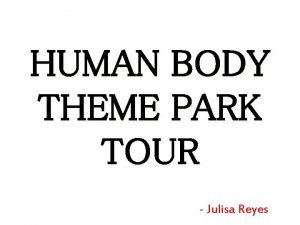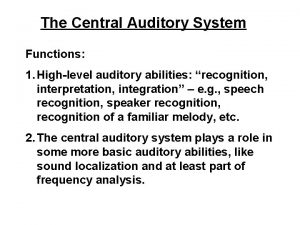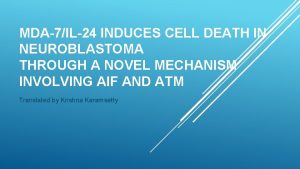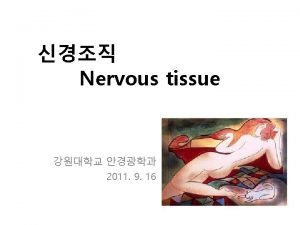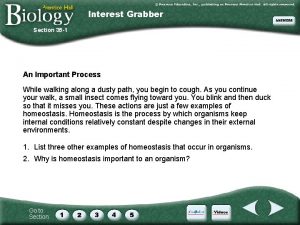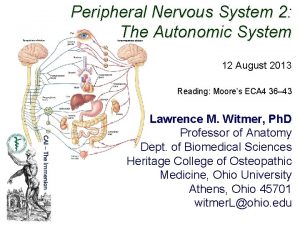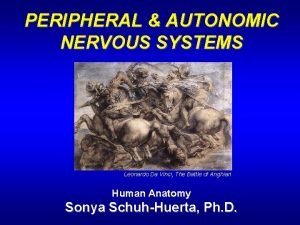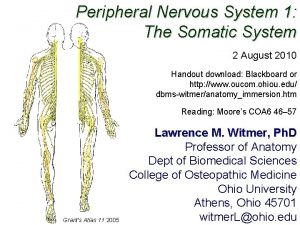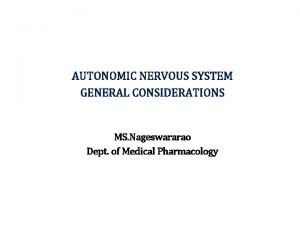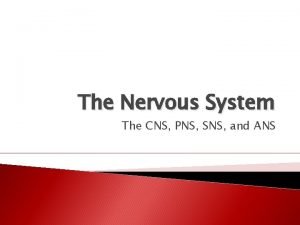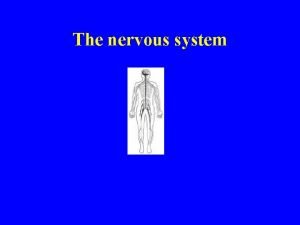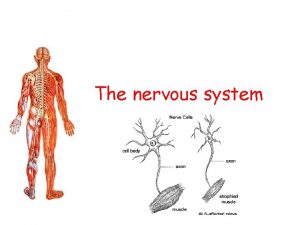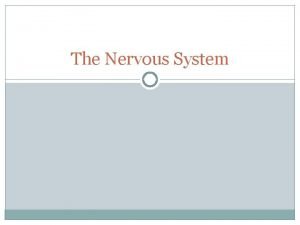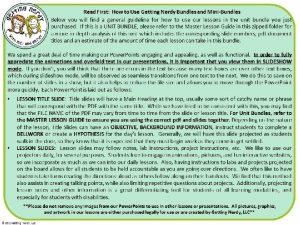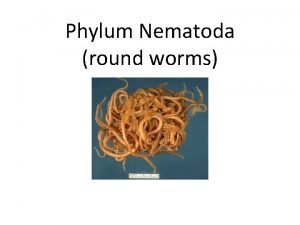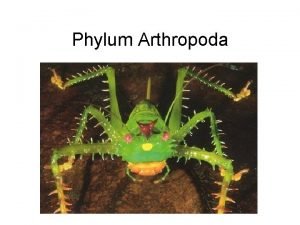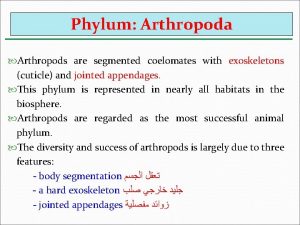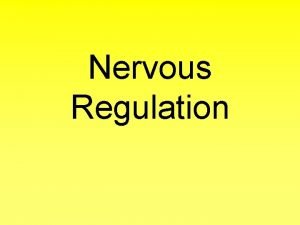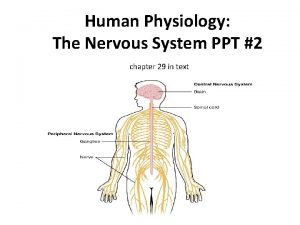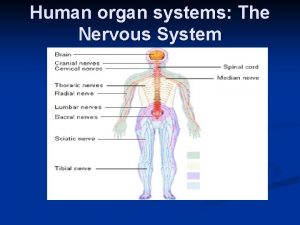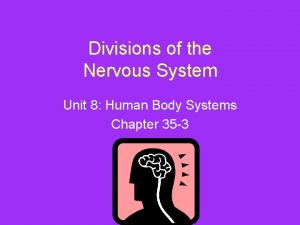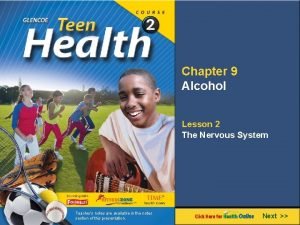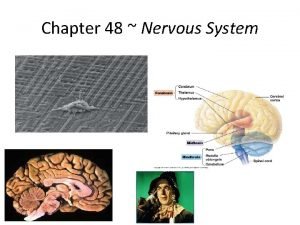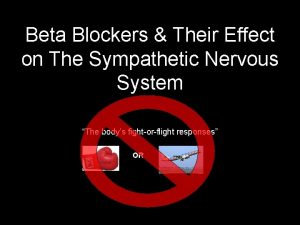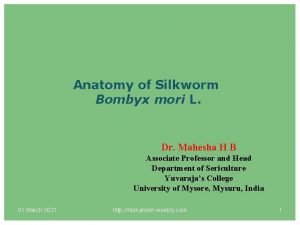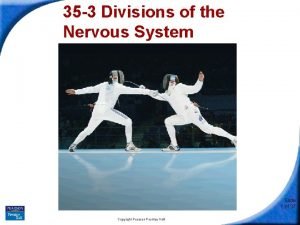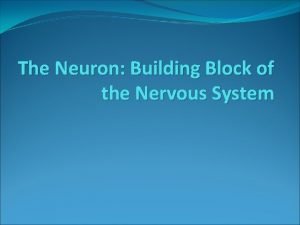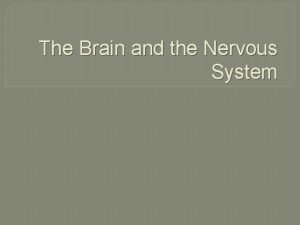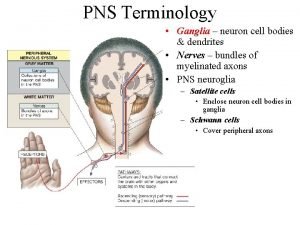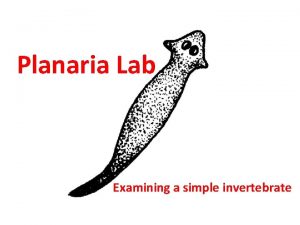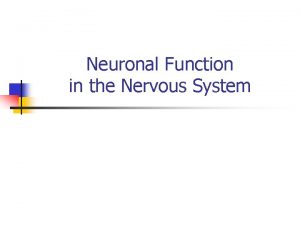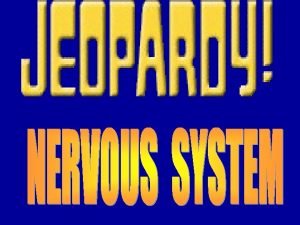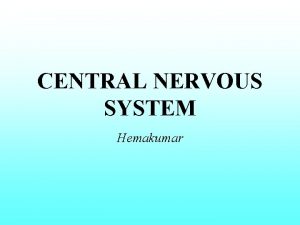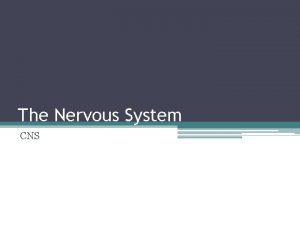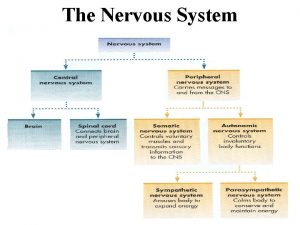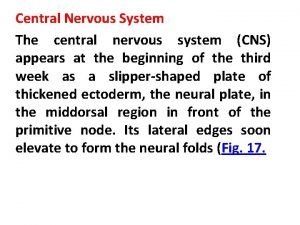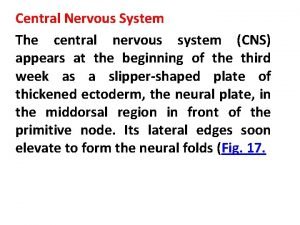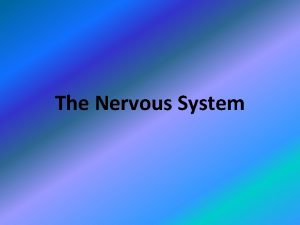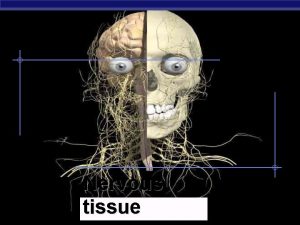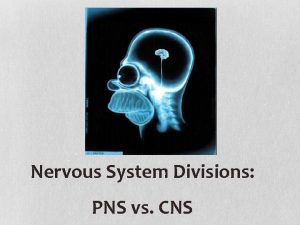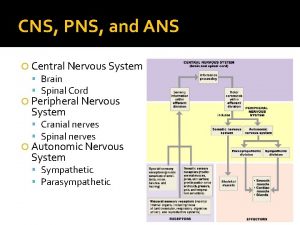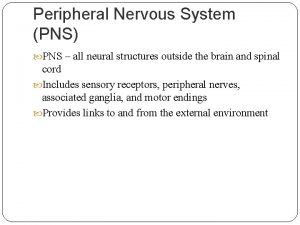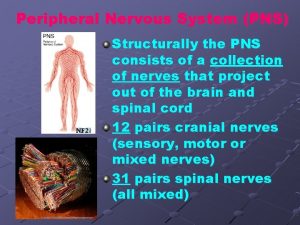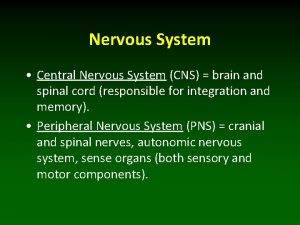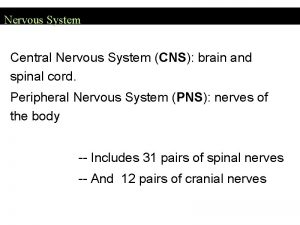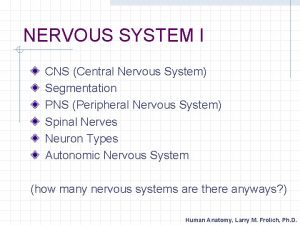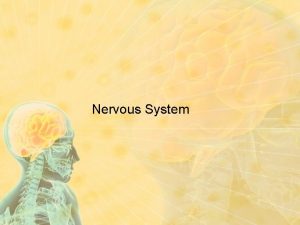CNS and PNS Central Nervous System CNS CNS






































































- Slides: 70

CNS and PNS


Central Nervous System (CNS) ¡CNS consists of brain and spinal cord

Adult Brain Regions 1. 2. 3. 4. Brain stem (midbrain, pons, and medulla) Cerebellum Diencephalon Cerebral hemispheres

Cerebral hemisphere Diencephalon Cerebellum Brain stem • Midbrain • Pons • Medulla oblongata

Brain Stem ¡ Three regions ¡ Midbrain ¡ Pons ¡ Medulla oblongata

Corpus callosum Fornix Lateral ventricle (covered by septum pellucidum) Thalamus Posterior commissure Pineal gland Third ventricle Epithalamus Corpora quadrigemina Cerebral aqueduct Anterior commissure Hypothalamus Arbor vitae Fourth ventricle Optic chiasma Cerebellum Mammillary body Pons Medulla oblongata Midbrain

Brain Stem ¡Controls automatic behaviors necessary for survival ¡ Breathing ¡ Circulation ¡ Digestion ¡ Swallowing

Frontal lobe Olfactory bulb (synapse point of cranial nerve I) Optic chiasma Optic nerve (II) Optic tract Mammillary body Midbrain Pons Temporal lobe Medulla oblongata Cerebellum Spinal cord

Midbrain ¡Associated with vision, hearing, motor control, sleep/wake, arousal (alertness), and temperature regulation. ¡Substantia nigra—functionally linked to basal nuclei

Tectum Periaqueductal gray matter Oculomotor nucleus (III) Medial lemniscus Red nucleus Substantia nigra Fibers of pyramidal tract Dorsal Cerebral aqueduct Reticular formation Ventral Midbrain Superior colliculus Crus cerebri of cerebral peduncle

Pons ¡Fibers of pons ¡Connect higher brain centers and spinal cord ¡Nuclei that relay signals from the forebrain to the cerebellum, ¡along with nuclei that deal primarily with sleep, respiration, swallowing, bladder control, hearing, equilibrium, taste, eye movement, facial expressions, facial sensation, and posture.

Superior cerebellar peduncle Trigeminal main sensory nucleus Trigeminal motor nucleus Middle cerebellar peduncle Trigeminal nerve (V) Medial lemniscus Pons Fourth ventricle Reticular formation Pontine nuclei Fibers of pyramidal tract

Medulla Oblongata: Functions ¡Cardiovascular center ¡ Cardiac center adjusts force and rate of heart contraction ¡Respiratory centers ¡ Generate respiratory rhythm ¡ Control rate and depth of breathing (with pontine centers)

Medulla Oblongata ¡Additional centers regulate ¡ Vomiting ¡ Hiccuping ¡ Swallowing ¡ Coughing ¡ Sneezing

Cerebellum ¡Input from cortex, brain stem and sensory receptors ¡Allows smooth, coordinated movements ¡ Learn to ride a bicycle

Anterior lobe Arbor vitae Cerebellar cortex Pons Fourth ventricle Medulla oblongata Posterior lobe Flocculonodular lobe Choroid plexus

Anterior lobe Primary fissure Posterior lobe Horizontal fissure Vermis

Cerebellar Processing of Motor Activity ¡Cerebellum receives impulses from cerebral cortex of intent to initiate voluntary muscle contraction ¡Continuously "inform" cerebellum of body's position and momentum ¡Proprioception ¡Smoothly coordinate muscle contraction

Basal Nuclei (Ganglia) ¡Caudate nucleus ¡Putamen ¡Globus pallidus

Striatum Caudate nucleus Putamen Thalamus Tail of caudate nucleus

Anterior Cerebral cortex Cerebral white matter Corpus callosum Anterior horn of lateral ventricle Head of caudate nucleus Putamen Globus pallidus Thalamus Tail of caudate nucleus Third ventricle Inferior horn of lateral ventricle Posterior

Functions of Basal Nuclei ¡Functions thought to be ¡ Helps in balance

Diencephalon ¡ Thalamus ¡ Hypothalamus ¡ Epithalamus

Cerebral hemisphere Corpus callosum Fornix Choroid plexus Septum pellucidum Interthalamic adhesion (intermediate mass of thalamus) Thalamus (encloses third ventricle) Posterior commissure Pineal gland Interventricular foramen Anterior commissure Hypothalamus Optic chiasma Pituitary gland Epithalamus Corpora quadrigemina Midbrain Cerebral aqueduct Mammillary body Pons Medulla oblongata Spinal cord Arbor vitae (of cerebellum) Fourth ventricle Choroid plexus Cerebellum

Thalamic Function ¡“Router” to cerebral cortex ¡Sorts, edits, and relays ascending input

Hypothalamus ¡Underneath the Thalamus ¡Contains many nuclei

Paraventricular nucleus Anterior commissure Preoptic nucleus Anterior hypothalamic nucleus Supraoptic nucleus Suprachiasmatic nucleus Optic chiasma Infundibulum (stalk of the pituitary gland) Fornix Arcuate nucleus Pituitary gland The main hypothalamic nuclei. Dorsomedial nucleus Posterior hypothalamic nucleus Lateral hypothalamic area Ventromedial nucleus Mammillary body

Hypothalamic Function ¡Controls autonomic nervous system (e. g. , blood pressure, rate and force of heartbeat, digestive tract motility, pupil size) ¡Physical responses to emotions (limbic system) ¡ Perception of pleasure, fear, and rage, and in biological rhythms and drives

Hypothalamic Function ¡Regulates sleep-wake cycles ¡Controls endocrine system ¡ Controls secretions of anterior pituitary gland ¡ Produces posterior pituitary hormones

Hypothalamic Function ¡Regulates body temperature – sweating/shivering ¡Regulates hunger and satiety in response to nutrient blood levels or hormones ¡Regulates water balance and thirst

Cerebral hemisphere Corpus callosum Fornix Choroid plexus Septum pellucidum Interthalamic adhesion (intermediate mass of thalamus) Thalamus (encloses third ventricle) Posterior commissure Pineal gland Interventricular foramen Anterior commissure Hypothalamus Optic chiasma Pituitary gland Epithalamus Corpora quadrigemina Midbrain Cerebral aqueduct Mammillary body Pons Medulla oblongata Spinal cord Arbor vitae (of cerebellum) Fourth ventricle Choroid plexus Cerebellum

Epithalamus ¡Connect the limbic system to other parts of the brain ¡ Regulation of emotions ¡Pineal gland secretes melatonin ¡ Involved in circadian rhythms © 2013 Pearson Education, Inc.

Corpus callosum Fornix Lateral ventricle (covered by septum pellucidum) Thalamus Posterior commissure Pineal gland Third ventricle Epithalamus Corpora quadrigemina Cerebral aqueduct Anterior commissure Hypothalamus Arbor vitae Fourth ventricle Optic chiasma Cerebellum Mammillary body Pons Medulla oblongata Midbrain

© 2013 Pearson Education, Inc.

© 2013 Pearson Education, Inc.

Lateralization of Cortical Function ¡Left hemisphere ¡ Controls language, math, and logic ¡Right hemisphere ¡ Visual-spatial skills, intuition, emotion, and artistic and musical skills ¡Hemispheres communicate almost instantaneously via fiber tracts and functional integration

© 2013 Pearson Education, Inc.

Cerebral Hemispheres ¡Five lobes ¡ Frontal ¡ Parietal ¡ Temporal ¡ Occipital ¡ Insula

Cerebral Cortex ¡Thin (2– 4 mm) superficial layer of gray matter ¡ 40% mass of brain ¡Site of conscious mind: awareness, sensory perception, voluntary motor initiation, communication, memory storage, understanding

4 General Considerations of Cerebral Cortex 1. Three types of functional areas ¡ Motor areas—control voluntary movement ¡ Sensory areas—conscious awareness of sensation ¡ Association areas—integrate diverse information 2. Each hemisphere concerned with contralateral side of body

Cerebral Hemispheres ¡Central sulcus ¡ Separates precentral gyrus of frontal lobe and postcentral gyrus of parietal lobe

Precentral gyrus Frontal lobe Central sulcus Postcentral gyrus Parietal lobe Parieto-occipital sulcus (on medial surface of hemisphere) Lateral sulcus Fissure (a deep sulcus) Occipital lobe Temporal lobe Transverse cerebral fissure Cerebellum Pons Medulla oblongata Spinal cord Gyrus Cortex (gray matter) Sulcus White matter Lobes and sulci of the cerebrum

Primary Motor Cortex ¡Motor homunculi - upside-down caricatures represent contralateral motor innervation of body regions

Frontal lobe Central sulcus Gyri of insula Temporal lobe (pulled down) Location of the insula lobe

Posterior Eye b Toes Genitals Face Jaw Swallowing e Ey se No e c Fa s Lip h Teet s Gum Jaw Tongue Lips Tongue rs m b Sensory map in postcentral gyrus Th u um Nec k Bro w Knee Leg Hip Trunk Neck Head Ar Elb m o Fo w rea rm Ha nd Foot Knee s er Th Anterior Hip Trunk d n Ha ng Fi der Shoul Arm ow Elb t s Wri Motor map in precentral gyrus Sensory Fi ng e Motor Primary motor cortex (precentral gyrus) Primary somatosensory cortex (postcentral gyrus) Pharynx Intraabdominal

Primary Somatosensory Cortex ¡In postcentral gyri of parietal lobe ¡Receives general sensory information Somatosensory homunculus upside-down caricatures represent contralateral sensory input from body regions

Posterior rs Sensory map in postcentral gyrus Th Foot um b Fi ng e Neck Head Ar Elb m o Fo w rea rm Ha nd Knee Leg Hip Trunk Anterior Sensory Genitals e Ey se No e c Fa s Lip h Teet s m Gu Jaw Tongue Primary somatosensory cortex (postcentral gyrus) Pharynx Intraabdominal

Visual Areas ¡Primary visual (striate) cortex ¡ Extreme posterior tip of occipital lobe ¡ Receives visual information from retinas

Motor areas Central sulcus Primary motor cortex Premotor cortex Frontal eye field Broca's area (outlined by dashes) Sensory areas and related association areas Primary somatosensory cortex Somatic Somatosensory sensation association cortex Gustatory cortex (in insula) Prefrontal cortex Working memory for spatial tasks Executive area for task management Working memory for object-recall tasks Solving complex, multitask problems Wernicke's area (outlined by dashes) Primary visual cortex Visual association area Auditory association area Primary auditory cortex Lateral view, left cerebral hemisphere Primary motor cortex Taste Motor association cortex Primary sensory cortex Sensory association cortex Vision Hearing Multimodal association cortex

Auditory Areas ¡Primary auditory cortex ¡ Superior margin of temporal lobes ¡ Interprets information from inner ear as pitch, loudness, and location

Motor areas Central sulcus Primary motor cortex Premotor cortex Frontal eye field Broca's area (outlined by dashes) Sensory areas and related association areas Primary somatosensory cortex Somatic Somatosensory sensation association cortex Gustatory cortex (in insula) Prefrontal cortex Working memory for spatial tasks Executive area for task management Working memory for object-recall tasks Solving complex, multitask problems Wernicke's area (outlined by dashes) Primary visual cortex Visual association area Auditory association area Primary auditory cortex Lateral view, left cerebral hemisphere Primary motor cortex Taste Motor association cortex Primary sensory cortex Sensory association cortex Vision Hearing Multimodal association cortex

OIfactory Cortex ¡Primary olfactory (smell) cortex ¡ Medial aspect of temporal lobes (in piriform lobes)

Motor areas Central sulcus Primary motor cortex Premotor cortex Frontal eye field Broca's area (outlined by dashes) Sensory areas and related association areas Primary somatosensory cortex Somatic Somatosensory sensation association cortex Gustatory cortex (in insula) Prefrontal cortex Working memory for spatial tasks Executive area for task management Working memory for object-recall tasks Solving complex, multitask problems Wernicke's area (outlined by dashes) Primary visual cortex Visual association area Auditory association area Primary auditory cortex Lateral view, left cerebral hemisphere Primary motor cortex Taste Motor association cortex Primary sensory cortex Sensory association cortex Vision Hearing Multimodal association cortex

Gustatory Cortex ¡In insula just deep to temporal lobe ¡Involved in perception of taste

Premotor cortex Cingulate Primary gyrus motor cortex Corpus callosum Central sulcus Primary somatosensory cortex Frontal eye field Parietal lobe Somatosensory association cortex Parieto-occipital sulcus Prefrontal cortex Occipital lobe Processes emotions related to personal and social interactions Orbitofrontal cortex Visual association area Olfactory bulb Olfactory tract Fornix Temporal Primary lobe olfactory cortex Parasagittal view, right cerebral hemisphere Primary motor cortex Motor association cortex Primary sensory cortex Uncus Calcarine sulcus Parahippocampal gyrus Sensory association cortex Primary visual cortex Multimodal association cortex

Limbic System: Emotion and Cognition ¡React emotionally to things we consciously understand to be happening ¡Consciously aware of emotional richness in our lives ¡Hippocampus and amygdaloid body—play a role in memory

Septum pellucidum Diencephalic structures of the limbic system Anterior thalamic nuclei (flanking 3 rd ventricle) Hypothalamus Corpus callosum Fiber tracts connecting limbic system structures Fornix Anterior commissure Cerebral structures of the limbic system Cingulate gyrus Septal nuclei Amygdaloid body Mammillary body Olfactory bulb Hippocampus • Dentate gyrus • Parahippocampal gyrus

Reticular Formation: RAS and Motor Function ¡Reticular activating system (RAS) ¡ Sends impulses to cerebral cortex to keep it conscious and alert ¡ Filters out repetitive, familiar, or weak stimuli (~99% of all stimuli!) ¡ ADHD ¡ Inhibited by sleep centers, alcohol, drugs ¡ Severe injury results in permanent unconsciousness (coma)

Radiations to cerebral cortex Visual impulses Auditory impulses Reticular formation Ascending general sensory tracts (touch, pain, temperature) Descending motor projections to spinal cord

Protection of the Brain ¡Bone (skull) ¡Membranes (meninges) ¡Watery cushion (cerebrospinal fluid) ¡Blood brain barrier

Meninges ¡Cover and protect CNS ¡Protect blood vessels and enclose venous sinuses ¡Contains cerebrospinal fluid (CSF) ¡Forms partitions in skull

Meninges ¡Three layers ¡ Dura mater ¡ Arachnoid mater ¡ Pia mater ¡Meningitis ¡ Inflammation of meninges

Skin of scalp Periosteum Superior sagittal sinus Subdural space Subarachnoid space Bone of skull Dura mater • Periosteal layer • Meningeal layer Arachnoid mater Pia mater Arachnoid villus Blood vessel Falx cerebri (in longitudinal fissure only)

Dura Mater ¡ Strongest layer

Arachnoid Mater ¡Middle layer with weblike extensions ¡Separated from dura mater by subdural space ¡Subarachnoid space contains CSF and largest blood vessels of brain ¡Arachnoid villi protrude into superior sagittal sinus and permit CSF reabsorption

© 2013 Pearson Education, Inc.

Skin of scalp Periosteum Superior sagittal sinus Subdural space Subarachnoid space Bone of skull Dura mater • Periosteal layer • Meningeal layer Arachnoid mater Pia mater Arachnoid villus Blood vessel Falx cerebri (in longitudinal fissure only)

Pia Mater ¡Delicate vascularized connective tissue that clings tightly to brain

© 2013 Pearson Education, Inc.
 Peripheral nervous system
Peripheral nervous system Neuron process
Neuron process Nervous
Nervous Fundamentals of the nervous system and nervous tissue
Fundamentals of the nervous system and nervous tissue Sensory system
Sensory system Major divisions
Major divisions Central and peripheral nervous system
Central and peripheral nervous system Central nervous system amusement park
Central nervous system amusement park Diagram of central nervous system
Diagram of central nervous system Building vocabulary activity: the central nervous system
Building vocabulary activity: the central nervous system Bser aer
Bser aer Chemical synapses
Chemical synapses Central nervous system for kids
Central nervous system for kids Nervous system and digestive system
Nervous system and digestive system Endocrine system
Endocrine system Endocrine system and nervous system
Endocrine system and nervous system Mechanism of hormone action
Mechanism of hormone action Central nervous sysytem
Central nervous sysytem The body's speedy electrochemical communication network
The body's speedy electrochemical communication network Section 35-1 human body systems answer key
Section 35-1 human body systems answer key Comparison of endocrine and nervous system
Comparison of endocrine and nervous system Chapter 15 nervous system diseases and disorders
Chapter 15 nervous system diseases and disorders Endocrine and nervous system comparison
Endocrine and nervous system comparison Rami ventralis
Rami ventralis Sympathetic and parasympathetic nervous system difference
Sympathetic and parasympathetic nervous system difference Somatic nervous system
Somatic nervous system Graphic organizer of nervous system
Graphic organizer of nervous system Autonomic nervous system pathway
Autonomic nervous system pathway Ans and cns difference
Ans and cns difference Dermatome map
Dermatome map Chemical messengers of the nervous system
Chemical messengers of the nervous system Bristle worm phylum
Bristle worm phylum The nervous system is made up of
The nervous system is made up of Three basic functions of the nervous system
Three basic functions of the nervous system Nervous system learning objectives
Nervous system learning objectives Chapter 7 the nervous system
Chapter 7 the nervous system Stimulus in nervous system
Stimulus in nervous system Neuron bundle
Neuron bundle Adrenal gland sympathetic nervous system
Adrenal gland sympathetic nervous system Alpha 1 receptors
Alpha 1 receptors Spinal nerves names
Spinal nerves names Sns somatic nervous system
Sns somatic nervous system Brain scienstructable
Brain scienstructable Somatic vs autonomic nervous system
Somatic vs autonomic nervous system Phylum
Phylum Arthropoda
Arthropoda Jointed foot
Jointed foot Nervous system of arthropods
Nervous system of arthropods Parasympathatic
Parasympathatic Nervous system of coelenterates
Nervous system of coelenterates Autonomic nervous system consists of
Autonomic nervous system consists of The nervous system
The nervous system Basic unit of nervous system
Basic unit of nervous system What is a pathogen
What is a pathogen Nervous system histology ppt
Nervous system histology ppt Grey matter of nervous system
Grey matter of nervous system 8 divisions of the nervous system
8 divisions of the nervous system How to take care of your nervous system
How to take care of your nervous system Nervous system effector cells
Nervous system effector cells Beta-blockers for overactive sympathetic nervous system
Beta-blockers for overactive sympathetic nervous system Somatic motor neuron
Somatic motor neuron Ganglion on spine
Ganglion on spine Anatomy of silkworm
Anatomy of silkworm 35-3 divisions of the nervous system
35-3 divisions of the nervous system What is the basic building block of the nervous system
What is the basic building block of the nervous system Structure of nervous system graphic organizer
Structure of nervous system graphic organizer Ganglion peripheral nervous system
Ganglion peripheral nervous system Classification of planaria
Classification of planaria Ctenophora kingdom
Ctenophora kingdom Learning objectives of nervous system
Learning objectives of nervous system Divisions of the nervous system
Divisions of the nervous system







